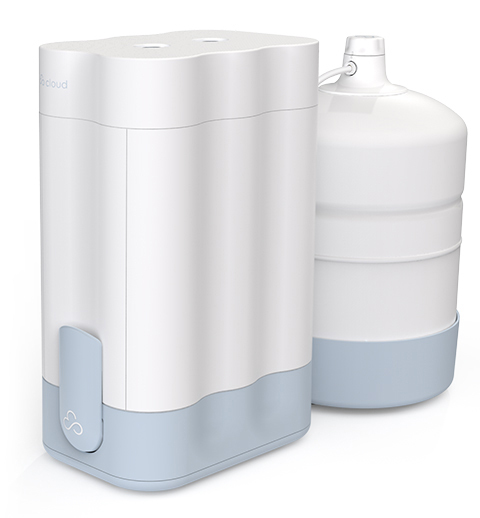Acidic water is water with a pH of less than 7.
The pH scale measures the acidity level of a solution.
7 is smack-dab in the middle.
14 is ultra alkaline (basic).
In other words, it can be a tad acidic, but not much more.
Next, we’ll take a closer look at the differences between alkaline water and acidic water.
Alkaline Water vs Acidic Water
To alkaline or not to alkaline, that is the question...
Compared to acidic water, alkaline water is far healthier to drink.
Early research indicates that alkaline water may have several health benefits, including:
- Improves blood flow
- Supports hydration
- Relieves acid reflux
- Improves sleep quality
- Strengthens bones
- Lowers blood sugar
In order to be truly alkaline, tap water must have a pH of between 8 and 9.
But alkaline water isn’t just about pH...
It should also contain essential minerals, like calcium and magnesium, which act as antioxidants that fight free radicals and prevent disease.
Not only that, but the minerals in alkaline water also conduct electricity, produce cellular energy, and support nearly every function in the human body.
Acidic water, on the other hand, often contains unhealthy heavy metals like arsenic and lead.
These metals can throw off the body’s pH and lead to some pretty gnasty side effects, but more on that in a sec…
For now, let’s take a closer look at what causes acidic water.
What Causes Acidic Water?
Acidic water can occur naturally from acid rain and organic soil run-off, but more often than not it’s caused by industrial pollution, like:
- Bisphenol-a (BPAs)
- Manufacturing operation byproducts
- Sewer overflows and wastewater releases
- Runoff from concentrated animal farming operations
These contaminants can harm your health and home.
5 Long-term Risks and Side Effects of Acidic Water
The pollutants found in acidic drinking water have been shown to irritate the gut lining, disrupt hormone production, and cause cancer.
However, even if your acidic water doesn’t contain nuclear waste, it can still do some serious damage.
Let’s take a closer look at the long-term side effects of acidic tap water:
Low-pH water can leach heavy metals like arsenic, lead, cadmium, copper, nickel and zinc.
Many of these elements, like zinc and copper, are healthy in small doses, but they can be potentially dangerous in high concentrations.
Arsenic and lead, however, are incredibly toxic at any dose.
Signs of heavy metal poisoning include:
- Weakness
- Loss of appetite
- Abdominal pain
- Abdominal cramps
- Diarrhea
- Vomiting
- Headaches
- Irritability
- Fatigue
- Chills
In general, children are much more vulnerable to heavy metal exposure.
2. Irritates the Gut Lining
When acidic water is caused by heavy metals, the contaminants can wreak havoc on the gut.
Even overexposure to zinc and copper, which are normally healthy in small doses, can cause diarrhea, nausea and vomiting.
With that said, naturally acidic water won’t necessarily damage the gut lining.
In fact, some studies show that, “The consumption of acidic water alters the gut microbiome and decreases the risk of diabetes.”
Unfortunately, a large percentage of acidic tap water contains some degree of heavy metals.
Have you ever had sensitive teeth after eating acidic fruits, like oranges and green apples?
That’s because the acid quickly erodes tooth enamel, the protective outer layer of the teeth, and acidic beverages can do the same thing.
According to recent studies, regularly drinking acidic beverages may slowly break down tooth enamel and increase the risk of cavities.
The bottom line is, acidic foods and beverages do a number on your teeth.
Acidic water can disrupt calcium absorption and lead to bone loss.
When researchers compared the effects of acidic drinking water vs alkaline water, they found that alkaline water improved calcium retention.
Plus, acidic water that contains heavy metals has been linked to osteoporosis and other degenerative bone diseases.
5. Damages the Plumbing In Your Home
Acidic water can take a toll on your plumbing.
Just like acidic beverages erode your tooth enamel, acidic water can corrode your pipes.
Signs of pipe damage from acidic water include:
- Blue-green stains in your sink
- A metallic taste to your water
- Plumbing leaks
The bottom line is, low-pH water eats away at pipes and increases the presence of heavy metals.
Pipes installed before 1986 are especially high-risk because they may contain lead.
How to Get Rid of Acidic Water and Balance pH
Are you ready to filter, purify and balance the pH of your drinking water?
In order to protect your entire home, you’ll want to install a whole-house reverse osmosis (RO) filter.
Whole-house systems balance pH at the point of entry, before acidic water can even touch your pipes.
However, whole-house systems can be pretty expensive.
If you just want safe, clean drinking water, then a point-of-use RO filter will do just fine.
Cloud Water Filters fit conveniently under the kitchen sink.
They use a sediment filter, carbon filter, ion exchange resins and reverse osmosis to remineralize, alkalize and balance the pH of your tap water, not to mention remove 99.9% of heavy metals and other contaminants.
Click here to learn more.

